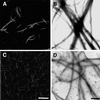The 65-kDa carrot microtubule-associated protein forms regularly arranged filamentous cross-bridges between microtubules
- PMID: 10611315
- PMCID: PMC24750
- DOI: 10.1073/pnas.96.26.14931
The 65-kDa carrot microtubule-associated protein forms regularly arranged filamentous cross-bridges between microtubules
Abstract
In plants, cortical microtubules (MTs) occur in characteristically parallel groups maintained up to one microtubule diameter apart by fine filamentous cross-bridges. However, none of the plant microtubule-associated proteins (MAPs) so far purified accounts for the observed separation between MTs in cells. We previously isolated from carrot cytoskeletons a MAP fraction including 120- and 65-kDa MAPs and have now separated the 65-kDa carrot MAP by sucrose density centrifugation. MAP65 does not induce tubulin polymerization but induces the formation of bundles of parallel MTs in a nucleotide-insensitive manner. The bundling effect is inhibited by porcine MAP2, but, unlike MAP2, MAP65 is heat-labile. In the electron microscope, MAP65 appears as filamentous cross-bridges, maintaining an intermicrotubule spacing of 25-30 nm. Microdensitometer-computer correlation analysis reveals that the cross-bridges are regularly spaced, showing a regular axial spacing that is compatible with a symmetrical helical superlattice for 13 protofilament MTs. Because MAP65 maintains in vitro the inter-MT spacing observed in plants and is shown to decorate cortical MTs, it is proposed that this MAP is important for the organization of the cortical array in vivo.
Figures





References
Publication types
MeSH terms
Substances
LinkOut - more resources
Full Text Sources

